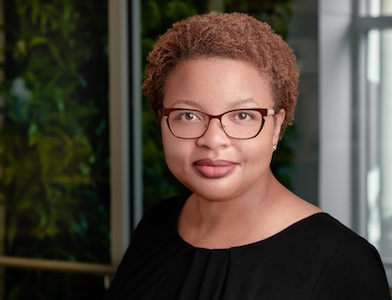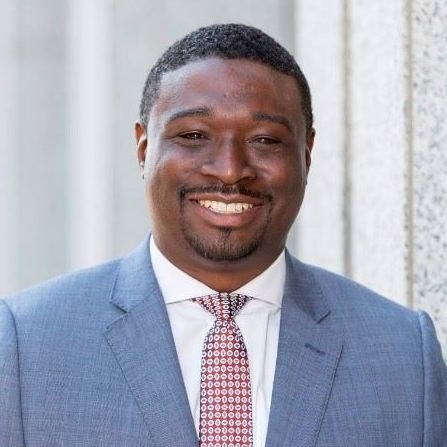Listen from Soundcloud at the bottom of the page
Season 3, Episode 10
The Relationship:

LaTresse Snead
LaTresse Snead is the new Director for The Nature Conservancy‘s Building Healthy Cities program lead global team of experts to help cities implement nature-based infrastructure and make communities more resilient to climate change. Prior to that, she was Deputy Director of their Global Cities program which included everything from greening megacities to creatively engaging the world’s billions of city dwellers with nature. She currently lives in the Atlanta metropolitan area, but grew up with Jahmal in Sacramento, California.

Wm. Jahmal Miller
Wm. Jahmal Miller is a System Vice President at Common Spirit Health in charge of diversity, equity, and inclusion. Prior to that, Jahmal was the Director of Corporate Reputation & Thought Leadership with Blue Shield of California’s External Affairs Division, and was also California’s first ever Health Equity Officer, appointed by Governor Jerry Brown in 2013 to lead the California Department of Public Health‘s Office of Health Equity. He currently resides in Sacramento, where he grew up with his childhood friend, LaTresse.
The Conversation:
LaTresse begins the conversation by talking about how there weren’t many people who looked like her around the table when she entered the conservation space and her experience with nature was vastly different from her colleagues: she knew nature by playing in the local cemetery, not by going on weekend kayak trips.
A clear message develops: to reach more people and help them understand the connection between nature, health, and equity, we need those diverse stories about how different groups of people view nature. This includes those who live in areas with a nature deficit or who don’t have many positive views of nature.
Jahmal emphasizes that to make effective and comprehensive change, we need to be including people with diverse academic and professional experiences, as well as those with unique lived experiences. A collaborative bilateral approach means that efforts are not just top-down or bottom-up, but the two emphasize that change starts from the ground up, from within communities.
The issues of nature, health equity, and social justice require that we change the narrative. Caring about the environment and worrying about climate change isn’t just for white tree huggers. Not only do marginalized communities of color have a unique relationship with nature and health, but it is also within underserved countries that change is happening and solutions are being found. And that is where empowerment comes from.
When we talk about re-imagining city and community infrastructure to include more nature-based solutions, gentrification can be a big issue. But how do we make improvements to a community while ensuring that it’s the long-time residents who are benefitting. The danger of improving neighborhoods and then pricing out the ones who have been living there for generations is a real threat.
Jahmal identifies two main takeaways from this conversation:
- Like this conversation, the question of nature and health equity requires collective impact. We need to peers coming together that bring both intellectual and demographic diversity to the conversation.
- There are places around the world that are tackling these issues and what we do locally can make an impact both domestically and globally. We need to learn from the communities that get it right, scale that impact, and teach others.
Topic Timestamps
Nature isn’t always accessible
- 00:00 – Sandy introduces the topic of nature, our relationship with it, and LaTresse Snead and Wm. Jahmal Miller.
- 01:18 – LaTresse talks about how there weren’t a lot of Black women or men or people of color in nature conservation when she started and how her experience with nature growing up was different from her colleagues: “Where I grew up, nature wasn’t always accessible.”
- 03:32 – To reach more people and help them understand the connection between nature, health, and equity, we need those diverse stories about how different groups of people view nature.
- 04:31 – It is important to listen to the people in communities and think about the role nature has played in people’s lives from a negative point of view.
- 05:29 – To get more people of color in this space, we need to be more open and change the narrative.
- 05:59 – Public health requires a collaborative bilateral approach: we need diverse academic and professional experiences, as well as unique lived experiences and perspectives.
- 07:44 – Nature deficits: much of urban development limits open green spaces. It is imperative to have a comprehensive approach to urban design and to help communities understand their relationship to nature.
Nature, health equity, and social justice: Change starts from the ground up
- 09:20 – Folks may feel disengaged and disenfranchised and they don’t understand the connection between urban design and the health of the community. Educating communities leads to community organizing, civic engagement, and healthier spaces.
- 11:13 – Interconnected issues: health care, environment and urban planning used to be talked about as separate issues, but now there are more conversations about collaborations and more about people talking about these issues as interconnected.
- 11:59 – It’s not just white tree huggers who are concerned about climate change, nature, and health. There are underserved communities that have come together to change the narrative and to embrace this role around nature, health equity, and social justice.
- 14:18 – LaTresse talks about Rev. Dr. Otis Moss III from Trinity United Church in Chicago who has led a partnership with health care institutions to bring better health care and nature into the community of Chicago’s South Side. He is an example of what we should all be doing: Change starts from the ground up, it starts in the community.
- 16:26 – At the core of it, it is really about empowerment and putting the tools and power back in to the community’s hands.
- 16:55 – Gentrification: how do you bring positive change to a community while making sure those improvements benefit the long-time residents instead of pricing them out?
Interconnectedness of our humanity around the world
- 19:42 – LaTresse’s biggest fear: “I don’t want to contribute to the displacement of people who have lived in these communities.”
- 21:33 – Social, economic, geographic, political, and physical conditions factor into the creation of a fair and just society. It is critical to keep these in mind as keys to how we redevelop and improve these communities.
- 22:38 – Get it right the first time: due to Sacramento’s gradual, rather than rapid, growth, it has to opportunity to plan thoughtfully around nature, the built environment, and health.
- 24:17 – Cities around the globe are all addressing this issue in different ways, from cities in China that are being built from the ground up with nature in mind, to cities in South and Southeast Asia that are struggling to agree on how to address the nature issues in the community.
- 25:54 – The unfortunate realities of climate-related changes connect us beyond our geographic boundaries. When it comes to policies and planning, we don’t live in silos; what we do locally affects others domestically and abroad.
- 27:44 – There is a lot of learning to be done from looking at the best practices around the globe and thinking about how we can share what we know with other cities.
- 28:34 – Jahmal’s first takeaway for listeners: with LaTresse’ background in nature and Jahmal’s background in health care, this conversation is an example of collective impact. We need to peers coming together that bring both intellectual and demographic diversity to the conversation.
- 30:22 – Jahmal’s second takeaway for listeners: Around the world there are region-based best practices where a community has got it right. But how do we scale it, standardize it, elevate it, and replicate it in our own communities, institutions, and systems?
Wrap Up | Let’s Do It
- 31:46 – LaTresse and Jahmal wrap up, commenting on the synergies between their work, reconnecting with a childhood friend, and moving forward to work together.
- 32:30 – Outro: make sure you’re an organ donor, write a former teacher a note, and be sure to send this episode along to someone you think should hear it.
Ways to listen to The Nonprofit Experience:
Like what you hear? Leave us a review on Apple Podcasts! It makes a big difference.

